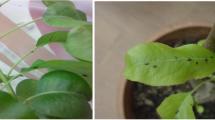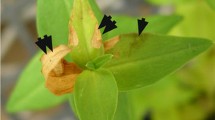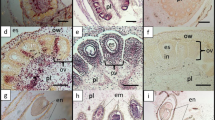Abstract
White leaf is one of the most destructive sugarcane diseases, threatening the sugarcane industry in the Asian region. A better understanding of the distribution and accumulation of sugarcane white leaf (SCWL) phytoplasma in the various parts of the host plants is important for selecting the most suitable sugarcane tissue for disease-free seed propagation materials and for proper disease detection. In this study, the multiplication and distribution of phytoplasma in 3-month-old sugarcane plants inoculated with SCWL phytoplasma in a specific area using the leafhopper vector, Matsumuratettix hiroglyphicus (Matsumura), were analyzed. Quantitative PCR was used to detect and quantify the SCWL phytoplasma that spread within the plant from the inoculated leaf to the main stem, top leaf, and root at 7 days post-inoculation (dpi). It then spread to the other leaves from the bottom to the top (14–28 dpi). The SCWL phytoplasma was detected throughout the plant by 35 dpi. The population of phytoplasma in the inoculated leaves, mainstem, and roots increased by approximately by 1–2-fold each week. At 6 and 9 months post-infection, the accumulation of phytoplasma was highest in the middle of the main stem, low in the new shoot and top internode, and moderate in the bottom internode. Therefore, the middle of the main stem is the preferred part from which tissue should be sampled for detection of SCWL in the mature plants.




Similar content being viewed by others
References
Arismendi, N.L., R. Riegel, and R. Carrillo. 2014. In vivo transmission of “Candidatus Phytoplasma ulmi” by Amplicephalus curtulus (Hemiptera: Cicadellidae) and its effect on ryegrass (Lolium multiflorum Cv. Tama). Journal of Economic Entomology 107: 83–91.
Braun, E.J., and W.A. Sinclair. 1978. Translocation in phloem necrosis-diseased American Elm seedlings. Phytopathology 86: 1733–1737.
Chandrasene, G., A.E. Brune, R.S. Rutherford, and N. Dharmawardena. 2003. Detection of phytoplasma associated with grassy shoot and white leaf disease of sugarcane in Sri Lanka using FTA™ papers. Sugar Tech 5: 237–241.
Chen, C.T. 1974. Sugarcane white leaf disease in Thailand and Taiwan. Sugarcane Pathologists’ Newsletter 11 (12): 23.
Christensen, N.M., M. Nicolaisen, M. Hansen, and A. Schulz. 2004. Distribution of phytoplasmas in infected plants as revealed by real-time PCR and bioimaging. Molecular Plant-Microbe Interactions 17: 1175–1184.
Constable, F.E., K.S. Gibb, and R.H. Symons. 2003. Seasonal distribution of phytoplasmas in Australian grapevines. Plant Pathology 52: 267–276.
Guthrie, J.N., K.B. Walsh, P.T. Scott, and T.S. Rasmussen. 2001. The phytopathology of Australian papaya dieback: A proposed role for the phytoplasma. Physiological and Molecular Plant Pathology 58: 23–30.
Hanboonsong, A.Y., W. Ritthison, C. Choosai, and P. Sirithorn. 2006. Transmission of sugarcane white leaf phytoplasma by Yamatotettix flavovittatus, a new leafhopper vector. Journal of Economic Entomology 99: 1531–1537.
Hanboonsong, Y., C. Choosai, S. Panyim, and S. Damak. 2002. Transovarial transmission of sugarcane white leaf phytoplasma in the insect vector Matsumuratettix hiroglyphicus (Matsumura). Insect Molecular Biology 11: 97–103.
Kartte, S., and E. Seemoller. 1991. Histopathology of apple proliferation in Malus taxa and hybrids of different susceptibility. Plant Pathology 131: 149–160.
Kollar, A., E. Seemiller, F. Bonnet, C. Saillard, and J.M. Bove. 1990. Isolation of the DNA of various plant pathogenic mycoplasmalike organisms from infected plants. Phytopathology 80: 233–237.
Lee, S., C. Kim, and B. Cha. 2012. Migration and distribution of graft-inoculated jujube witches’-broom phytoplasma within a Cantharanthus roseus plant. Plant Pathology Journal 28: 191–196.
Lherminier, J.L., M. Courtois, and A. Caudwell. 1994. Determination of the distribution and multiplication sites of Flavescence Dor’ee mycoplasma-like organisms in the host plant Vicia faba by ELISA and immunocytochemistry. Physiology and Molecular Plant Pathology 45: 125–138.
Maust, B.E., F. Espadas, C. Talavera, M. Aguilar, J.M. Santamaría, and C. Oropeza. 2003. Changes in carbohydrate metabolism in coconut palms infected with the lethal yellowing phytoplasma. Phytopathology 93: 976–981.
Nakashima, K., S. Kato, S. Iwanami, and N. Murata. 1993. DNA probes reveal relatedness of rice yellow dwarf mycoplasmalike organisms (MLOs) and distinguish them from other MLOs. Applied and Environmental Microbiology 59: 1206–1212.
Saracco, P., D. Bosco, F. Veratti, and C. Marzachi. 2006. Quantification over time of chrysanthemum yellows phytoplasma (16Sr-I) in leaves and roots of the host plant Chrysanthemum carinatum (Schousboe) following inoculation with its insect vector. Physiology and Molecular Plant Pathology 67: 212–219.
Wei, W., S. Kakizawa, S. Suzuki, H.-Y. Jung, H. Nishigawa, S.-I. Miyata, K. Oshima, M. Ugaki, T. Hibi, and S. Namba. 2004. In planta dynamic analysis of onion yellows phytoplasma using localized inoculation by insect transmission. Phytopathology 94: 244–250.
Wei, W., H. Kawakita, and M. Sato. 2000. Detection of a small population of mulberry dwarf (DM)-phytoplasmas in symptomless-mulberry trees by nested PCR. The Journal of Sericultural Science of Japan 69: 261–269.
Wongkaew, P., Y. Hanboonsong, P. Sirithorn, C. Choosai, S. Boonkrong, T. Tinnangwattana, R. Kitchareonpanya, and S. Damak. 1997. Differentiation of phytoplasmas associated with sugarcane and gramineous weed white leaf disease and sugarcane grassy shoot disease by RFLP and sequencing. Theoretical and Applied Genetics 95: 660–663.
Yi, J.C., T.H. Lim, and B. Cha. 2001. Changes in phytoplasma densities in witches’ broom-infected jujube trees over seasons. The Plant Pathology Journal 17: 295–299.
Acknowledgements
This study was supported by the Royal Golden Jubilee PhD program of the Thailand Research Fund and Khon Kaen University (Grant No. PHD/0162/2554), and partially supported by the Japan International Research Center for Agricultural Sciences. The authors would like to thank the Khon Kaen and Thapra Field Crops Research Centers, Thailand, for providing sugarcane tissue plants for the study.
Author information
Authors and Affiliations
Corresponding author
Ethics declarations
Conflict of interest
The all authors declare that they have no conflict of interest.
Rights and permissions
About this article
Cite this article
Roddee, J., Kobori, Y. & Hanboonsong, Y. Multiplication and Distribution of Sugarcane White Leaf Phytoplasma Transmitted by the Leafhopper, Matsumuratettix hiroglyphicus (Matsumura) (Hemiptera: Cicadellidae), in Infected Sugarcane. Sugar Tech 20, 445–453 (2018). https://doi.org/10.1007/s12355-017-0559-x
Received:
Accepted:
Published:
Issue Date:
DOI: https://doi.org/10.1007/s12355-017-0559-x




